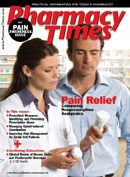Publication
Article
Pharmacy Times
Rx PRODUCT NEWS PROFILE: A Closer Look at New FDA Actions: Nucynta
Author(s):
Ms. Domenici and Ms. Patel are both pharmacists at Brigham and Women’s Hospital in Boston, Massachusetts. Ms. Viscusi is a sixth-year pharmacy student at Massachusetts College of Pharmacy in Boston, Massachusetts.
PriCara’s Nucynta
On June 23, 2009, the FDA announced the approval of Nucynta (tapentadol) immediate-release tablets, manufactured by PriCara, a division of Ortho-McNeil-Janssen Pharmaceuticals Inc. Nucynta is a CII immediate-release tablet for the relief of moderate-to-severe acute pain in patients 18 years and older.1
Clinical Pharmacology
Nucynta is an oral analgesic that works centrally via opioid and nonopioid activity.2 Nucynta inhibits the reuptake of norepinephrine and agonizes mu-opioid receptors.3 The exact mechanism of Nucynta is unknown, however.3
Pharmacokinetics
Nucynta dosing should be individualized according to the severity of pain as well as previous experience with similar drugs.4 For the treatment of moderate-to-severe acute pain, initiate Nucynta at a dose of 50, 75, or 100 mg every 4 to 6 hours, depending on pain intensity. If adequate pain control is not established with the first dose, a second dose may be administered as soon as 1 hour after the first dose. Maximum dosing on the first day is 700 mg.4 Please note that Nucynta is indicated for relief of moderate to severe acute pain in patients 18 years of age or older; it is not indicated for chronic pain.4
Nucynta has approximately 32% bioavailability, without regard to food.3 Nucynta has a half-life of approximately 4 hours and is 97% hepatically metabolized with an extensive first-pass effect. The major route is glucuronidation with minor cytochrome P450 enzyme metabolism to inactive metabolites. Nucynta is 99% renally excreted: 70% conjugated metabolite and 3% unchanged drug.3
Dose adjustments are only recommended in patients with moderate hepatic impairment. Dose adjustments are not recommended in patients with mild renal/hepatic impairment or patients with moderate renal impairment. Nucynta is not recommended in patients with severe renal or hepatic impairment.3 Nucynta is not recommended for patients younger than 18 years of age due to insufficient data.3
Clinical Trials
In order to obtain FDA approval, efficacy and safety were determined using 2 randomized, double-blind, active- and placebo-controlled, multiple-dose studies of moderate to severe pain from first metatarsal bunionectomy and end-stage degenerative joint disease. The end-stage degenerative joint disease study demonstrated the efficacy of 50- and 75-mg Nucynta, given every 4 to 6 hours during waking hours for 10 days in patients aged 18 to 80. A total of 666 patients experiencing moderateto- severe pain from end-stage degenerative joint disease of the hip or knee were enrolled in the study. The subjects received Nucynta 50 or 75 mg; oxycodone immediate-release (IR) 10 mg; or placebo every 4 to 6 hours for 10 days.5
No significant difference in efficacy between the patients receiving Nucynta compared with those receiving oxycodone were reported. Nucynta was found to have significantly better gastrointestinal tolerability (less nausea and/or vomiting and constipation than oxycodone IR), however.5
Precautions/Contraindications
Nucynta should be used with caution during pregnancy (Category C), and is not recommended for use in women during and immediately prior to labor and delivery.4 Although no conclusive data are available in humans of Nucynta being excreted in breast milk, nursing mothers should not use Nucynta.4
Lower doses of Nucynta are recommended in the geriatric population due to chance of decreased renal and/or hepatic impairment.4
Respiratory depression is a primary risk of mu-opioid agonists. Nucynta is contraindicated in patients with significantly impaired pulmonary function. Opioid analgesics can increase cerebrospinal fluid pressure and should not be used in patients who have evidence of head injury and increased intracranial pressure.4
Serotonin syndrome is potentially life threatening, which may occur with the use of serotonin and norepinephrine reuptake inhibitors, including Nucynta. Patients taking selective serotonin reuptake inhibitors, tricyclic antidepressants, triptans, and drugs that impair metabolism of serotonin should use caution while taking Nucynta. Concomitant use of monoamine oxidase inhibitors is contraindicated.4
Nucynta may cause spasm of the sphincter of Oddi, due to its mu-opioid activity, and should be used with caution in patients with biliary tract disease, including acute pancreatitis.3 Nucynta is contraindicated in patients with paralytic ileus.3 Nucynta carries the same risk of dependence, misuse, and abuse as other conventional opioid agonists.3
References
1. Nucynta (tapentadol) CII Immediate-Release Tablets Now Available for Relief of Moderate to Severe Acute Pain [press release]. www.jnj.com/connect/news/all/20090623_080000. Accessed July 25, 2009.
2. Nucynta [safety information]. Nucynta Web site. http://nucynta.com/nucynta/index.html. Accessed July 25, 2009.
3. Nucynta. In DRUGDEX [database]. Greenwood Village, Colorado: Thomson Reuters (Healthcare) Inc. Updated periodically. Accessed July 28, 2009.
4. Nucynta [package insert]. Titusville, NJ: Ortho-McNeil-Janssen Pharmaceuticals Inc; 2009.
5. Hartrick C, Van Hove I, Stegmann J, Oh C, Upmalis D. Efficacy and tolerability of tapentadol immediate release and oxycodone HCl immediate release in patients awaiting primary joint replacement surgery for end-stage joint disease: a 10-day, phase III, randomized, double-blind, active- and placebo-controlled study. Clin Ther. 2009;31(2):1-12.







